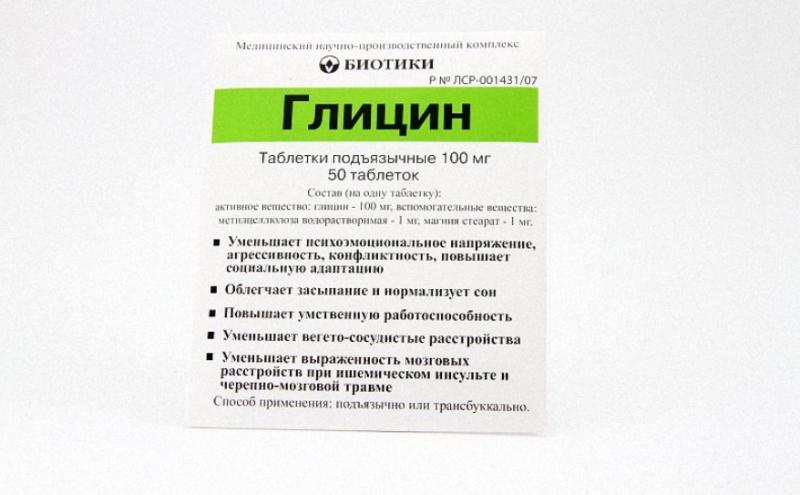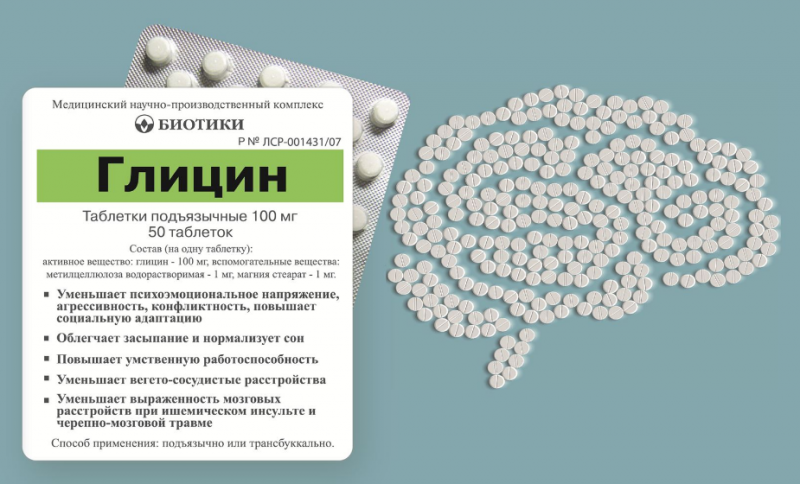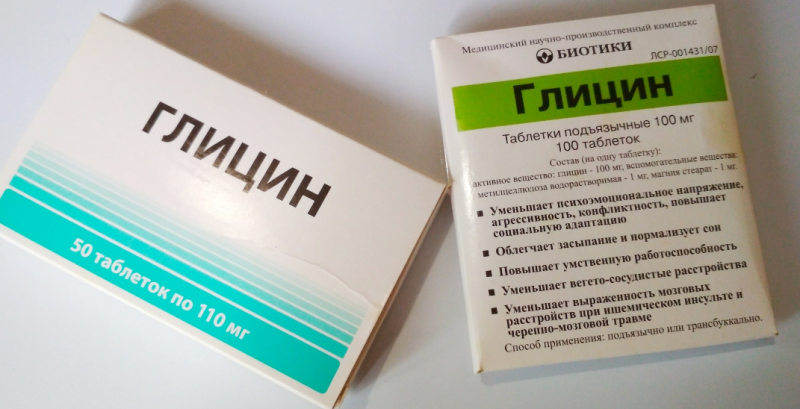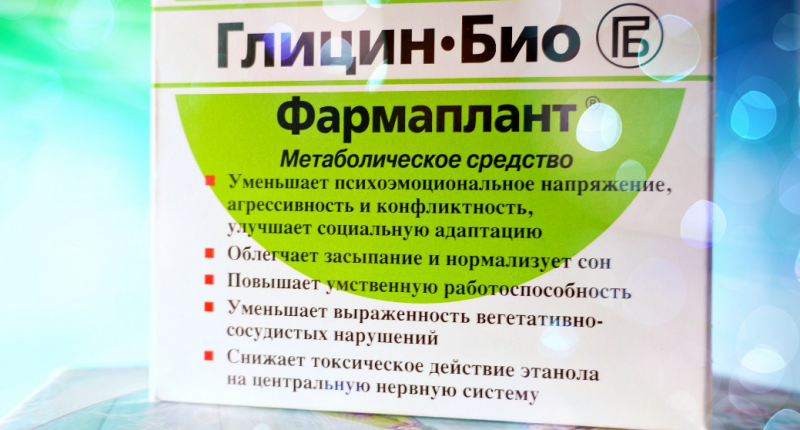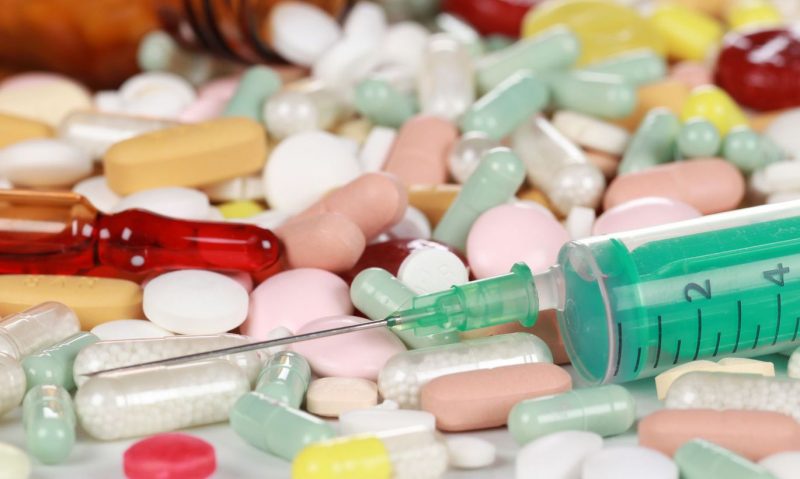“Glycine” is one of the most popular nootropic drugs prescribed for people of any age category. This medicine refers to complex metabolic agents. Glycine tablets normalize cerebral circulation, help reduce the load on the psyche and improve cognitive function. The tool is safe, well tolerated by the body and has a fairly large list of indications for use.
Material Content:
Release form, composition and packaging
The main active ingredient of the tablets is the amino acid of the same name - glycine. Small tablets, 100 mg of active ingredient in each. The amino acid itself has a sweetish flavor, so the tablets have a pleasant taste. There are few excipients in the composition - only magnesium stearate and methyl cellulose.
The drug is produced by many pharmaceutical companies. The most common is the product of Biotiki. It is just one large blister with 50 small white tablets. The blister is packed in a cardboard envelope pack, which details the indications and methods of using the medicine.
In general, pharmacies present drugs from other manufacturers, which may differ in packaging and dosage.
"Glycine" is safe and does not cause dangerous side effects, therefore it is dispensed without a prescription.
Why is Glycine prescribed?
A drug refers to metabolic drugs, or nootropics.The drug improves cerebral circulation, normalizes metabolic processes and improves cognitive functions of the brain.
Instructions for use suggest taking the medicine in the following cases:
- deterioration of mental performance against the background of fatigue;
- stress
- psycho-emotional stress;
- deviant behavior of children and adolescents;
- neurosis;
- neurocirculatory dystonia (VVD);
- negative effects of traumatic brain injury;
- encephalopathies of various origins;
- sleep disturbances.
In other words, the medicine can be taken in any situations in which the nervous system needs outside help and support.
Amino acid increases resistance to stress, improves brain function and positively affects mental abilities.
It is recommended to take it in moments of strong mental and mental stress to improve concentration. So, students often take this medicine during the session to be able to better remember information.
The drug is used in the fight against neurosis and neurosis-like conditions. As an aid, Glycine can be taken for obsessive-compulsive disorder, anxiety, and panic attacks.
The drug improves cerebral circulation, protects brain tissue from the effects of hypoxia, and therefore is used as part of rehabilitation therapy after a stroke.
The medicine is included in the list of first-line drugs for alcoholic encephalopathy.
Instructions for use and dosage for children and adults
Glycine is a small sublingual tablet for sublingual administration. The tablet is placed under the tongue and left until completely resorbed. The second method of application is buccal, that is, the tablet remains behind the cheek until it is completely dissolved.
Children can be given powder by pre-grinding a tablet in a mortar.
The standard dosage is the same for adults and children - 1 tablet three times a day. Such a regimen is indicated during periods of stress, strong mental stress, and also for the treatment of sleep problems.
The duration of the course of treatment is set individually for each, and in general, is from two to five weeks.
- To eliminate the effects of ischemic stroke and restore nervous activity, large doses of the drug are practiced - 10 tablets in the first five days. Then, therapy with a standard dose of the drug (300 mg per day) continues for a month.
- In severe brain lesions, a large dose of “Glycine” is often prescribed during the first few hours after a stroke.
- With psycho-emotional shocks and emotional lability, the medicine is taken 2 tablets per day for two weeks.
- Students during the session can take 2 tablets of medication per day for 14 days.
- For problems with falling asleep, you should take 1 tablet of the medicine half an hour before going to bed.
How to take Glycine for an adult and a child, the indications determine. Dosage is selected individually.
In some cases, it is more convenient to take the drug "Glycine Forte", which contains 300 mg of amino acid in one tablet.
During pregnancy and lactation
Exact studies of the effect of amino acids on the fetus have not been conducted, therefore, a metabolic agent is not recommended for pregnant women.
It is not known for sure whether the drug can pass into breast milk, therefore, during lactation, taking this medicine is also prohibited.
Compatibility with alcohol and other drugs
Like other drugs that regulate the metabolic processes of the central nervous system, Glycine is incompatible with alcohol.
This drug is able to enhance the effect of antipsychotics, tranquilizers and sedative drugs. In addition, Glycine significantly reduces the toxicity of these drugs.
Concomitant use with other sedatives requires caution due to the potentiation of sedation, which can lead to a decrease in blood pressure and daytime sleepiness.
Contraindications, side effects
The medicine is usually well tolerated and does not cause side effects.
There are not many contraindications at all, they include:
- individual intolerance to amino acids or any other component of the composition;
- children under 3 years old;
- pregnancy and lactation;
- low blood pressure.
The drug enhances the processes of inhibition of the nervous system, which must be taken into account when working with mechanisms and driving vehicles. In addition, “Glycine” slightly reduces blood pressure, which can be a problem for patients with hypotension. In this case, it is important to monitor fluctuations in blood pressure and be prepared to take urgent measures with a strong decrease.
With arterial hypotension, the recommended dosage can be reduced.
The drug is safe, there are no cases of severe side effects. With intolerance, a skin allergic reaction and local discomfort are possible - dryness and sore throat, allergic rhinitis and conjunctivitis. If allergy symptoms appear, stop taking the medicine.
"Glycine" for children should be prescribed only by a pediatrician. The dosage of “Glycine” in this case is selected individually and depends on the age of the patient. As a rule, children 4-12 years old are prescribed half the adult dosage.
Metabolic analogues
Analogues of "Glycine" to pick up is quite problematic, since there are no drugs with the same composition. Here it is necessary to take into account the indications for use.
- As a sedative to improve sleep, you can use Novo-Passit.
- To treat the effects of ischemic stroke, alcoholic encephalopathy, and manifestations of neurocirculatory dystonia, Mexiprim, Cavinton, and Armadin are prescribed.
It is recommended not to self-medicate, but to consult a doctor about the prescription of the drug to replace "Glycine."


